Disseminating the Past in 3D: O Corro dos Mouros and Its Ritual Landscape (Galicia, Spain)
Abstract
1. Introduction
1.1. Digital Technologies in Archaeological Documentation
1.2. Objectives and Technological Approach
2. Materials and Methods
2.1. The Choice of Site and Its Characteristics
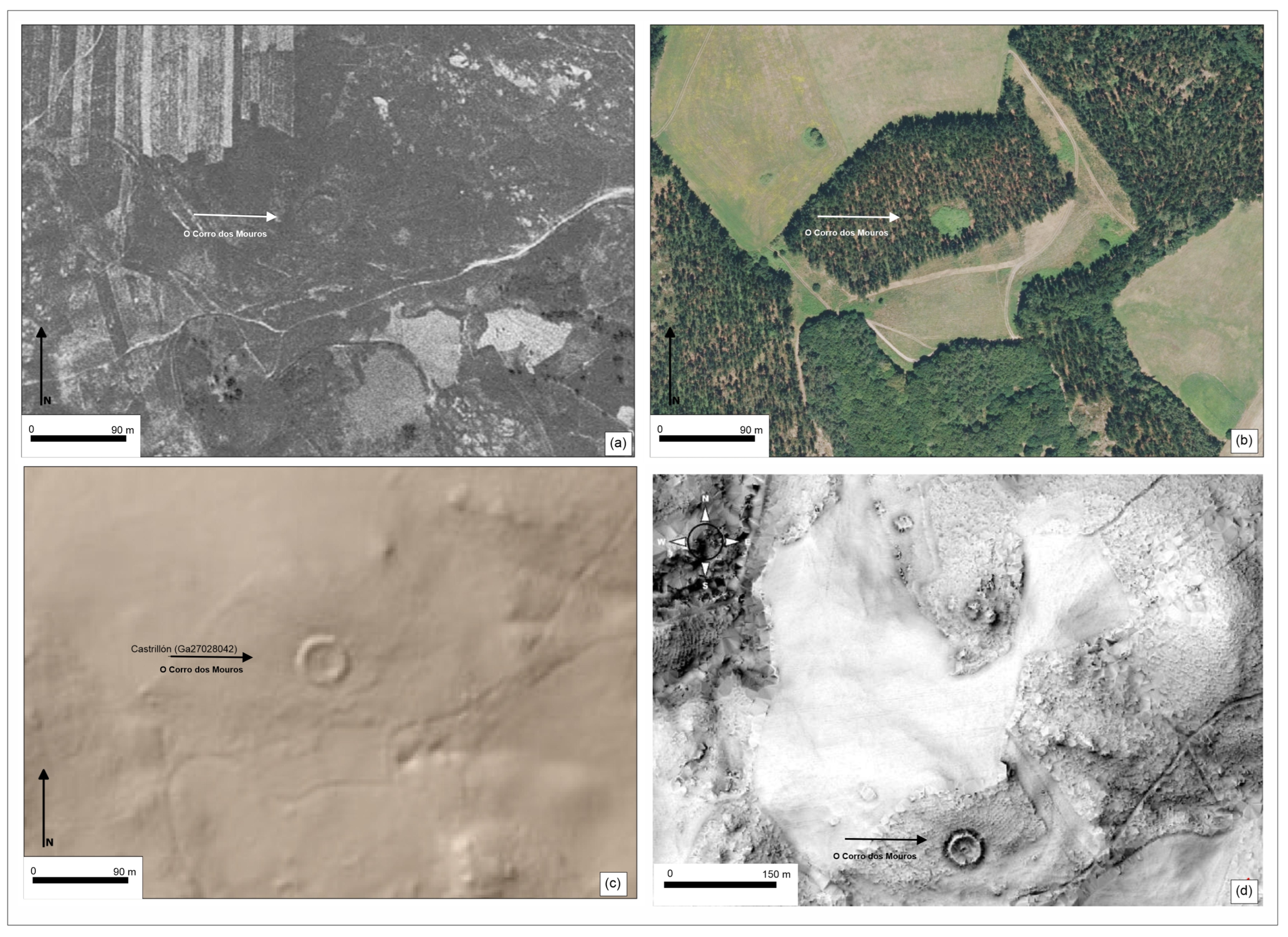
2.2. Flowchart of the Process
2.3. Fusion of LiDAR-UAV and SfM Photogrammetry for High-Resolution 3D Archaeological Documentation
3. Results
3.1. LiDAR and Photogrammetric Fusion: Data Visualisation and Terrain Modelling
3.2. Online Publication
4. Discussion
5. Conclusions and Perspectives
Supplementary Materials
Author Contributions
Funding
Institutional Review Board Statement
Data Availability Statement
Acknowledgments
Conflicts of Interest
References
- Staropoli, L.; Acevedo, V.J.; Ávido, D.N.; Vitores, M. Reflexiones En La Práctica de La Arqueología Digital: La Construcción y Comunicación Del Patrimonio Cultural Virtual. Virtual Archaeol. Rev. 2023, 14, 118–135. [Google Scholar] [CrossRef]
- García-Molina, D.F.; González-Merino, R.; Rodero-Pérez, J.; Carrasco-Hurtado, B. Documentación 3D Para La Conservación Del Patrimonio Histórico: El Castillo de Priego de Córdoba. Virtual Archaeol. Rev. 2021, 12, 115. [Google Scholar] [CrossRef]
- Sokol, O.L.; Salerno, V. Bienes “Públicos” y Lo Digital En La Arqueología Argentina. Rev. Mus. Antropol. 2023, 16, 363–376. [Google Scholar] [CrossRef]
- Roteta Lannes, C.; Pupio, M.A.; Mazzia, N. La Fotogrametría En Las Estrategias de Comunicación: Análisis Del Uso de Modelos 3D En La Arqueología Bonaerense. Rev. Mus. Antropol. 2024, 17, 331–346. [Google Scholar] [CrossRef]
- Laurent, A.; Coupry, B.; Brument, B.; Mélou, J.; Quéau, Y.; Fritz, C.; Durou, J.-D. Combining Geometric and Photometric 3D Reconstruction Techniques for Cultural Heritage. J. Cult. Herit. 2025, 73, 43–51. [Google Scholar] [CrossRef]
- Schroder, W.; Murtha, T.; Golden, C.; Scherer, A.K.; Broadbent, E.N.; Almeyda Zambrano, A.M.; Herndon, K.; Griffin, R. UAV LiDAR Survey for Archaeological Documentation in Chiapas, Mexico. Remote Sens. 2021, 13, 4731. [Google Scholar] [CrossRef]
- Aldrighettoni, J.; D’Urso, M.G. Military Archaeology and LIDAR Data Visualizations: A Non-Invasive Approach to Detect Historical Remains. Acta IMEKO 2023, 12, 1–10. [Google Scholar] [CrossRef]
- Mascort-Albea, E.J.; Ruiz Jaramillo, J.; Romero-Hernández, R. Analizando El Patrimonio Cultural a Través de Vuelos No Tripulados: Nuevas Estrategias de Investigación de Espacios Rurales y Urbanos. Virtual Archaeol. Rev. 2014, 5, 55. [Google Scholar] [CrossRef]
- Mészáros, J. Aerial Surveying Uav Based on Open-Source Hardware and Software. Int. Arch. Photogramm. Remote Sens. Spat. Inf. Sci. 2012, 38, 155–159. [Google Scholar] [CrossRef]
- Cruz Franco, P.A.; de la Rueda Márquez Plata, A.; Pérez Sendín, M. Investigating a Workflow for Obtaining Physical Models from Digital Twins Obtained through Photogrammetry and TLS: New Ways for a Sustainable Dissemination of Heritage. Appl. Sci. 2023, 13, 1057. [Google Scholar] [CrossRef]
- Peña-Villasenín, S.; Gil-Docampo, M.; Ortiz-Sanz, J. Professional SfM and TLS vs. a Simple SfM Photogrammetry for 3D Modelling of Rock Art and Radiance Scaling Shading in Engraving Detection. J. Cult. Herit. 2019, 37, 238–246. [Google Scholar] [CrossRef]
- Guarnieri, A.; Remondino, F.; Vettore, A. Digital Photogrammetry and Tls Data Fusion Applied to Cultural Heritage 3D Modeling. Int. Arch. Photogramm. Remote Sens. Spat. Inf. Sci. 2006, 36, 1–6. [Google Scholar]
- Lorenzo, G.; López, L.; Moralejo, R.A.; del Papa, L.M. SfM Photogrammetry Applied to Taxonomic Determination of Archaeofauna Remains. Virtual Archaeol. Rev. 2019, 10, 70–83. [Google Scholar] [CrossRef]
- García Lerena, M.S.; López, L. Relevamiento Del Patrimonio Histórico Rural Mediante Fotogrametría (SfM-MVS) En La Región Pampeana Argentina. “Primera Estancia” de Magdalena (Buenos Aires, Argentina). Arqueología 2021, 27, 169–181. [Google Scholar] [CrossRef]
- Gil-Docampo, M.; Peña-Villasenín, S.; Bettencourt, A.M.S.; Ortiz-Sanz, J.; Peraleda-Vázquez, S. 3D Geometric Survey of Cultural Heritage by UAV in Inaccessible Coastal or Shallow Aquatic Environments. Archaeol. Prospect. 2023, 32, 19–34. [Google Scholar] [CrossRef]
- Peña Villasenín, S. Aplicaciones de La Fotogrametría de Bajo Coste al Estudio de Patrimonio Arqueológico y Arquitectónico. Ph.D. Thesis, Universidade de Santiago de Compostela, A Coruña, Spain, 2019. [Google Scholar]
- Wilkinson, M.W.; Jones, R.R.; Woods, C.E.; Gilment, S.R.; McCaffrey, K.J.W.; Kokkalas, S.; Long, J.J. A Comparison of Terrestrial Laser Scanning and Structure-from-Motion Photogrammetry as Methods for Digital Outcrop Acquisition. Geosphere 2016, 12, 1865–1880. [Google Scholar] [CrossRef]
- Herrero, M.J.; Pérez-Fortes, A.P.; Escavy, J.I.; Insua-Arévalo, J.M.; De la Horra, R.; López-Acevedo, F.; Trigos, L. 3D Model Generated from UAV Photogrammetry and Semi-Automated Rock Mass Characterization. Comput. Geosci. 2022, 163, 105121. [Google Scholar] [CrossRef]
- Li, Z. New Opportunities for Archaeological Research in the Greater Ghingan Range, China: Application of UAV LiDAR in the Archaeological Survey of the Shenshan Mountain. J. Archaeol. Sci. Rep. 2023, 51, 104182. [Google Scholar] [CrossRef]
- Guo, Q.; Su, Y.; Hu, T.; Zhao, X.; Wu, F.; Li, Y.; Liu, J.; Chen, L.; Xu, G.; Lin, G.; et al. An Integrated UAV-Borne Lidar System for 3D Habitat Mapping in Three Forest Ecosystems across China. Int. J. Remote Sens. 2017, 38, 2954–2972. [Google Scholar] [CrossRef]
- Filip-Gherman, M.; Bruma, S.; Sabou, C.; Nap, M.; Suba, E.-E.; Sălăgean, T. The Cross-Disciplinary Influence of Aerial Measurement Techniques: Exploring Archaeological Studies through Photogrammetry and LiDAR. Nova Geod. 2024, 4, 154. [Google Scholar] [CrossRef]
- Quintilla Castan, M.; Agustín-Hernández, L. Los Sistemas de Documentación Como Instrumento de Conservación Del Patrimonio Arquitectónico. Experiencias En España y Europa. Erph Rev. Electrón. Patrim. Hist. 2023, 41–75. [Google Scholar] [CrossRef]
- Marín-Buzón, C.; Pérez-Romero, A.M.; León-Bonillo, M.J.; Martínez-Álvarez, R.; Mejías-García, J.C.; Manzano-Agugliaro, F. Photogrammetry (SfM) vs. Terrestrial Laser Scanning (TLS) for Archaeological Excavations: Mosaic of Cantillana (Spain) as a Case Study. Appl. Sci. 2021, 11, 11994. [Google Scholar] [CrossRef]
- Rodríguez-Bulnes, J. LIDAR XXI: Técnicas Topográficas Del Siglo XXI Aplicadas a La Detección de Yacimientos Arqueológicos Ocultos Por Vegetación. LIDAR XXI: Topographic Techniques of the XXI Century Applied to the Detection of Archaeological Sites Hidden by Vegetation. UNES Univ. Esc. Y Soc. 2023, 16, 171–185. [Google Scholar] [CrossRef]
- Tobalina Pulido, L.; Polo Romero, L.A.; Suárez López, P.A. La Necrópolis de Santa Ana (Guzmán, Burgos). Localización y Caracterización Mediante Prospección Superficial. Arqueol. Y Territ. Mediev. 2025, 32, e9051. [Google Scholar] [CrossRef]
- Nonat, L.; Prieto Martinez, M.P.; Vazquez Liz, P. Les contextes funéraires et le dynamisme culturel du nord-ouest de la péninsule Ibérique entre le XVIIIE siècle et le VIIIE siècle avant J.-C. In Funerary Practices in the Second Half of the Second Millennium BC in Continental Atlantic Europe. From Belgium to the North of Portugal; Nonat, E.L., Prieto, P., Eds.; Archaeopress Archaeology: Oxford, UK, 2022; pp. 128–156. [Google Scholar]
- Prieto Martínez, M.P.; Cordeiro Maañón, L. Ritual sites from the Second Millennium BC in the North West of Spain. In Funerary Practices in the Second Half of the Second Millennium BC in Continental Atlantic Europe: From Belgium to the North of Portugal; Nonat, E.L., Prieto, P., Eds.; Archaeopress Archaeology: Oxford, UK, 2022; pp. 187–199. [Google Scholar]
- Vázquez Liz, P.; Prieto-Martínez, M.P.; Núñez Jato, J.F. El pasado olvidado: El sitio del II y I milenio BC de Pena Fita (Adai, Lugo) en el contexto de las ‘longhouses’ del NW peninsular. Gallaecia 2015, 34, 9–56. [Google Scholar] [CrossRef]
- Cano Pan, J.A.; Piay Augusto, D.; Naveiro López, J.L. Un Yacimiento Ceremonial en la Transición del Bronce al Hierro: Ventosiños (Coeses, Lugo); Arqueoloxia do Noroeste SLU: Cambre, Spain, 2015. [Google Scholar]
- Prieto Martínez, M.P. Actuación Arqueolóxica de Investigación e Documentación do Xacemento Arqueolóxico de Corro dos Mouros/O Castrillón/Os Curros—GA27028042—(Santa María Madalena de Adai, Lugo) Código SXPA: CT 102A 2023/653-0, Expte. S. Arqueoloxía: 02.L.566.2023.001; Unpublished Preliminary Report; Xunta de Galicia: A Coruña, Spain, 2023.
- Prieto Martínez, M.P. Actuación Arqueolóxica de Investigación e Documentación do Xacemento Arqueolóxico de Corro dos Mouros/O Castrillón/Os Curros—GA27028042—(Santa María Madalena de Adai, Lugo). Código SXPA: CT 102A 2024/324-0, Expte. S. Arqueoloxía: 02.L.566.2024.001; Unpublished Report; Xunta de Galicia: A Coruña, Spain, 2024.
- Valle Abad, P.; Lago Cerviño, M.; Ruanova Álvarez, N.; Arqueóloga, A.; Fernández Fernández, A. Proyecto SENTINELA. Técnicas y Procedimientos Para El Registro Del Patrimonio Cultural Inmueble. Minius 2024, 29. [Google Scholar] [CrossRef]
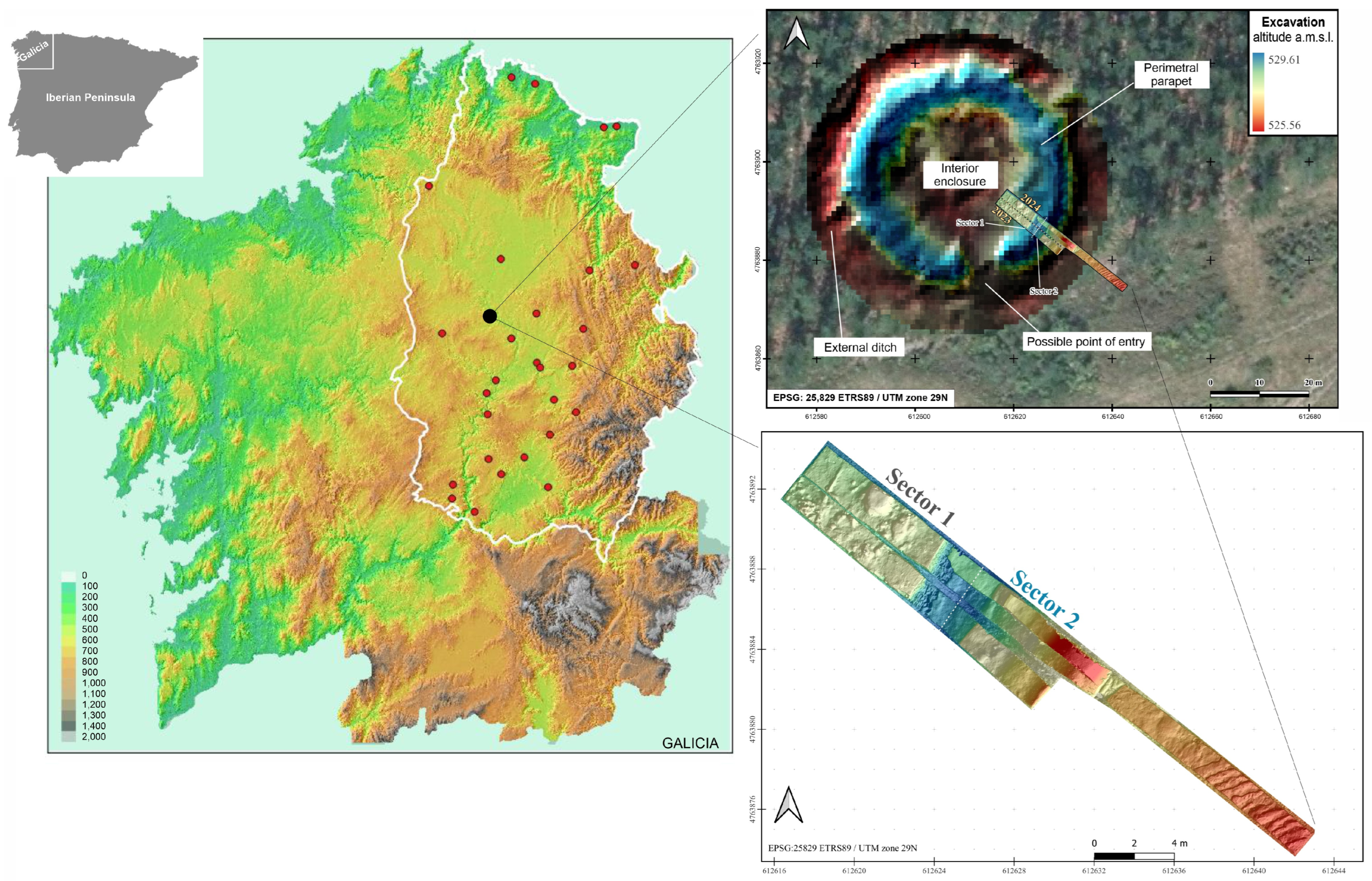



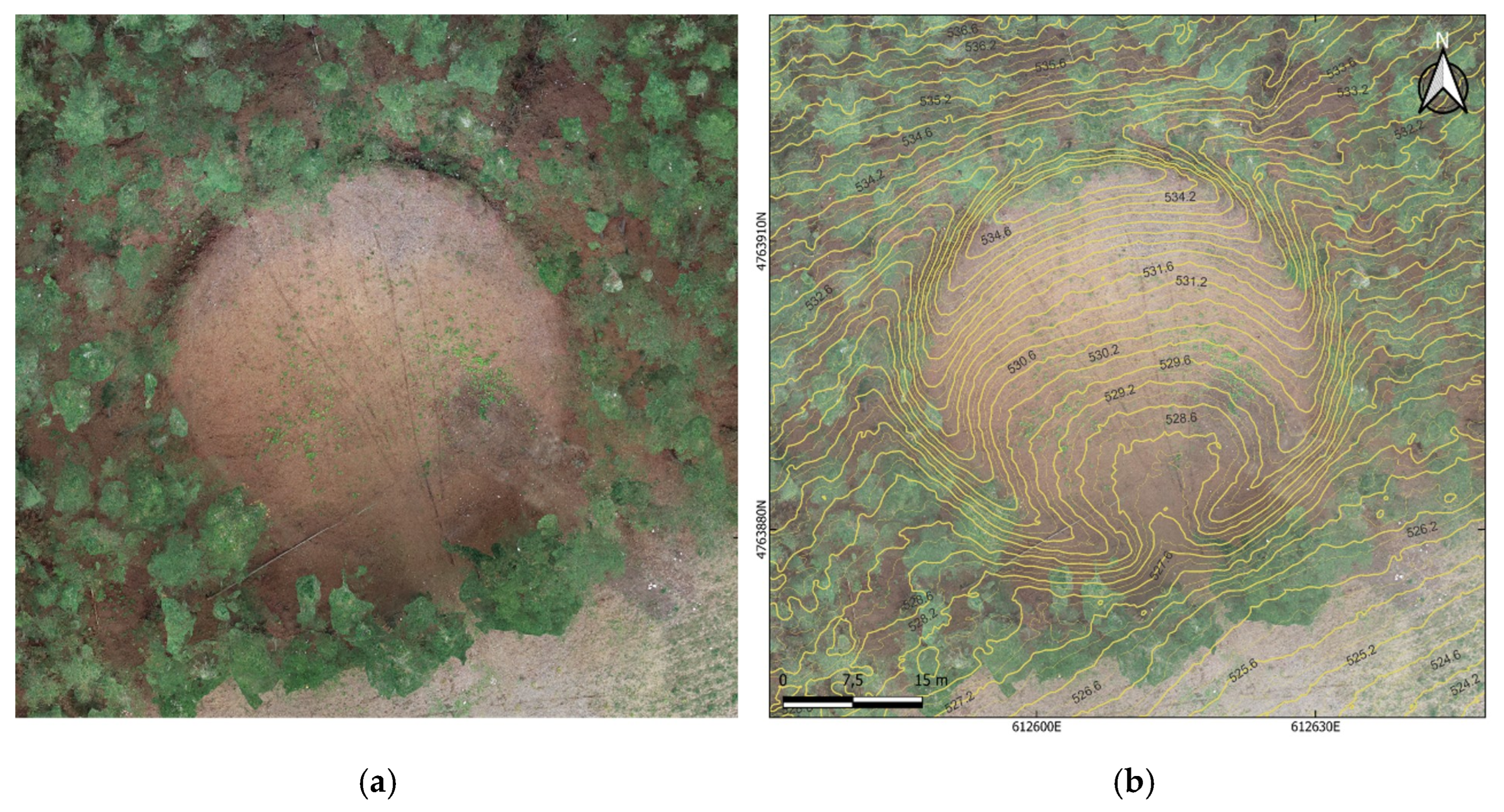
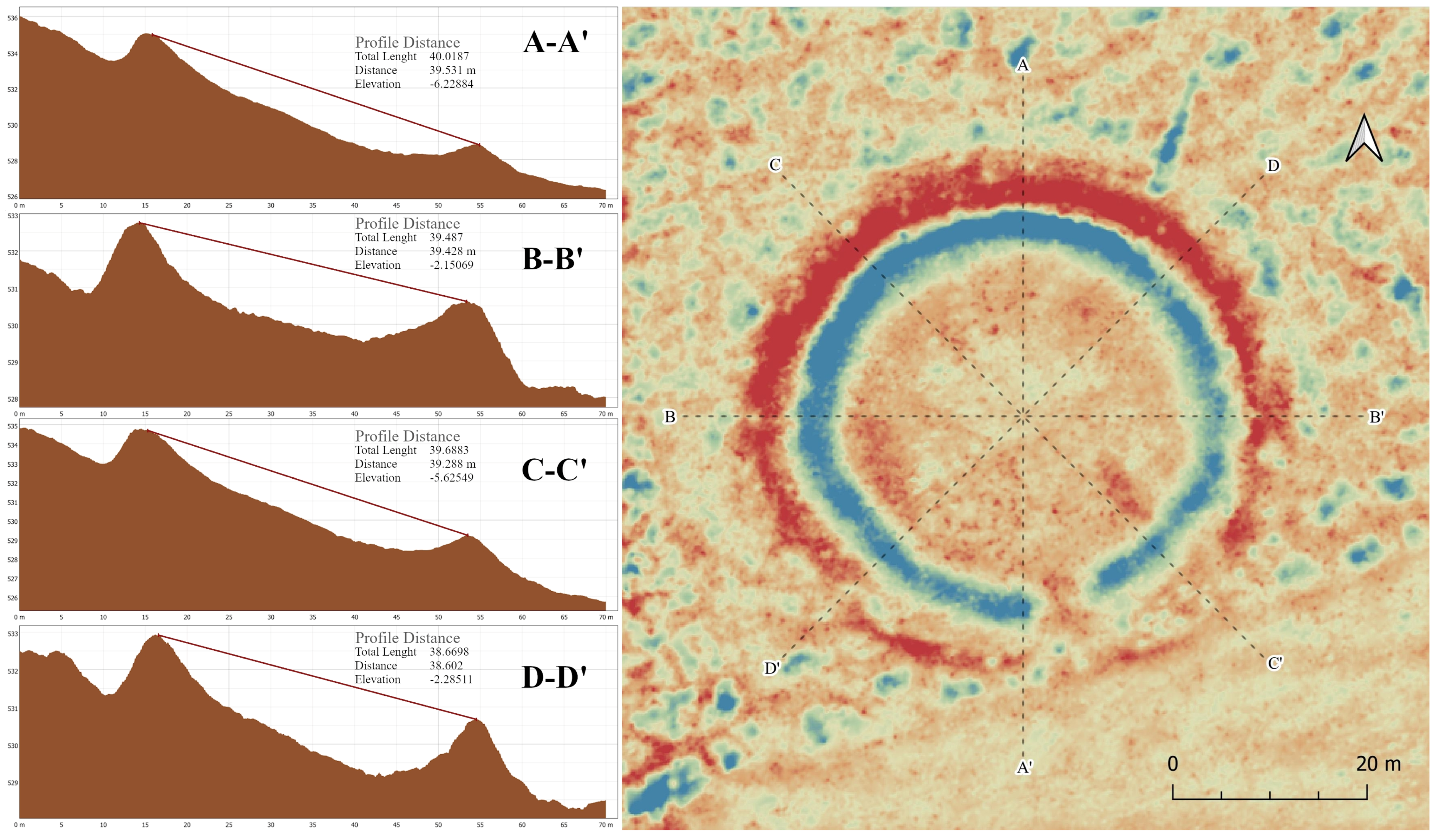

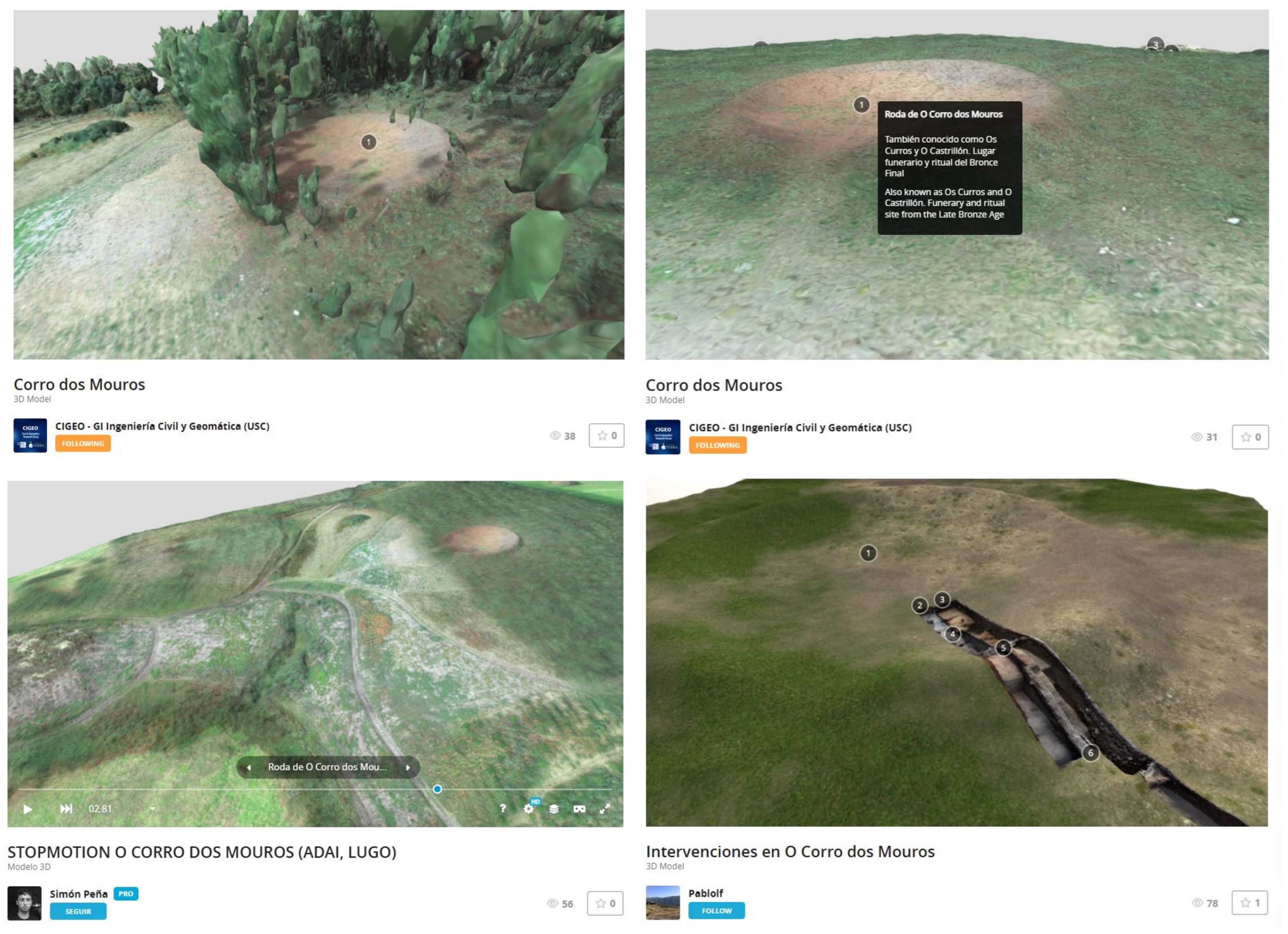
| Software | Costs ($) |
|---|---|
| Agisoft Metashape (Professional Edition) | 4.000 |
| DJI Terra Pro | 5.000 |
Disclaimer/Publisher’s Note: The statements, opinions and data contained in all publications are solely those of the individual author(s) and contributor(s) and not of MDPI and/or the editor(s). MDPI and/or the editor(s) disclaim responsibility for any injury to people or property resulting from any ideas, methods, instructions or products referred to in the content. |
© 2025 by the authors. Licensee MDPI, Basel, Switzerland. This article is an open access article distributed under the terms and conditions of the Creative Commons Attribution (CC BY) license (https://creativecommons.org/licenses/by/4.0/).
Share and Cite
Gil-Docampo, M.; López-Juanes, R.; Peña-Villasenín, S.; López-Fernández, P.; Ortiz-Sanz, J.; Prieto-Martinez, M.P. Disseminating the Past in 3D: O Corro dos Mouros and Its Ritual Landscape (Galicia, Spain). Appl. Sci. 2025, 15, 6025. https://doi.org/10.3390/app15116025
Gil-Docampo M, López-Juanes R, Peña-Villasenín S, López-Fernández P, Ortiz-Sanz J, Prieto-Martinez MP. Disseminating the Past in 3D: O Corro dos Mouros and Its Ritual Landscape (Galicia, Spain). Applied Sciences. 2025; 15(11):6025. https://doi.org/10.3390/app15116025
Chicago/Turabian StyleGil-Docampo, Mariluz, Rocío López-Juanes, Simón Peña-Villasenín, Pablo López-Fernández, Juan Ortiz-Sanz, and María Pilar Prieto-Martinez. 2025. "Disseminating the Past in 3D: O Corro dos Mouros and Its Ritual Landscape (Galicia, Spain)" Applied Sciences 15, no. 11: 6025. https://doi.org/10.3390/app15116025
APA StyleGil-Docampo, M., López-Juanes, R., Peña-Villasenín, S., López-Fernández, P., Ortiz-Sanz, J., & Prieto-Martinez, M. P. (2025). Disseminating the Past in 3D: O Corro dos Mouros and Its Ritual Landscape (Galicia, Spain). Applied Sciences, 15(11), 6025. https://doi.org/10.3390/app15116025









